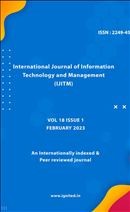Identification of the main Innovation Management Techniques (IMTS) aiming the Improvement of Firm Competitiveness by Means of Knowledge Management
Main Article Content
Authors
Abstract
One of the main differentiating factors among businesses nowadays, according to open innovation, is their capacity to take in information from outside sources. very small enterprises (VSEs) approaches to and management of innovation, however, have received less consideration. Actually, the majority of VSEs lack the competence to independently execute innovation. Methodological approaches to knowledge management that seek to increase businesses' competitiveness are known as innovation management techniques (IMTs). In this study, we create, test, and assess a novel IMT-indented approach for VSEs in underdeveloped locations, like India's Chhattisgarh. According to the outcomes of the pilot IMT application, the entrepreneurs had a favorable reaction. The results of this research provide credence to the idea that, regardless of a company's size, innovation implementation is directly correlated with its inventive people resource.
Downloads
Article Details
Section
References
- Ahuja, G. (2020) Collaboration networks, structural holes, and innovation: a longitudinal study. Administrative Science Quarterly, 45, 3, 425-455.
- Bell, D. (2018) The Comings of Post Industrial Society. London: Heineman.
- Bullinger, H.J., Auernhammer, K. and Gomeringer, A. (2017) Managing innovation networks in the knowledge-driven economy. International Journal of Product Research, 42, 17, 3337-3353.
- Chesbrough, H.W. (2019) The era of open innovation. MIT Sloan Management Review, 44, 3, 35-41.
- Clark, C. (2020) The Conditions of Economic Progress. New York: McMillan.
- James, W.M. (2022) Best HR practices for today's innovation management. Research Technology Management, 45, 1, 57-60.
- Kipping, M. and Engwall, L. (2022) Management Consulting. Emergence and Dynamics of a Knowledge Industry. UK: Oxford University Press.
- Kline, S.J. and Rosenberg, N. (2017) An Overview of Innovation. In Landau, R. and Rosenberg, N. (eds.), The Positive Sum Strategy. Harnessing Technology for Economic Growth. Washington, DC: National Academy Press, pp. 275-306.
- Machlup, F. (2021) The Production and Distribution of Knowledge in the United States, Princeton University Press.
- Oslo, Manual (2017) The Measurement of Scientific and Technological Activities. Proposed Guidelines for Collecting and Interpreting Technological Innovation Data, Paris: OECD.
- Phaal, R., Farrukh, C.I.P. and Probert, D.R. (2016) Technology management tools: concept, development and application. Technovation, 26, 336-344.
- Schlegelmilch, B.B., Diamantopoulos, A. and Kreuz, P. (2017) Strategic innovation: the construct, its drivers and its strategic outcomes. Journal of Strategic Marketing, 11, 2, 117-132.
- Ram, S. (2020) Validation of expert systems for innovation management: issues, methodology and empirical assessment. Journal of Product Innovation Management, 13, 53-68.
- Utterback, J.M. (2018) Mastering the Dynamics of Innovation. How Companies can Seize Opportunities in the Face of Technological Change. Boston, MA: Harvard Business School Press.
- Von Hippel, E. (2019) The Sources of Innovation. Oxford: Oxford University Press

